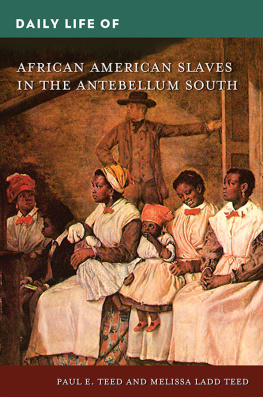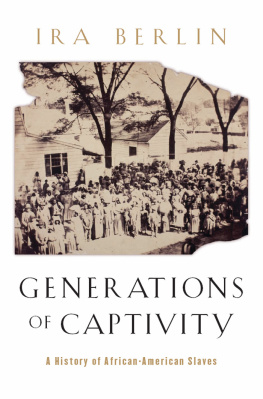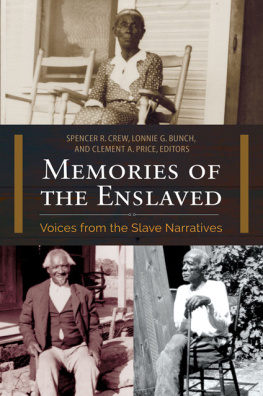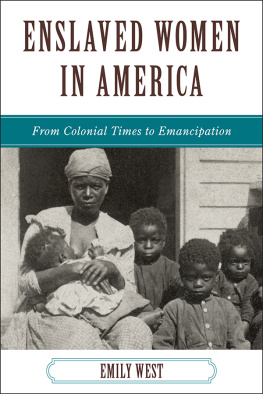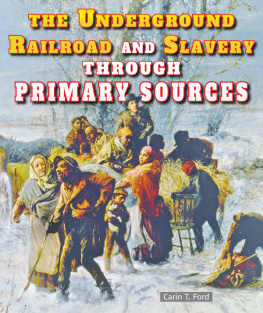DAILY LIFE OF
AFRICAN AMERICAN SLAVES IN THE ANTEBELLUM SOUTH
Recent Titles in
The Greenwood Press Daily Life Through History Series
The Colonial South
John Schlotterbeck
A Medieval Monastery
Sherri Olson
Arthurian Britain
Deborah J. Shepherd
Victorian Women
Lydia Murdoch
The California Gold Rush
Thomas Maxwell-Long
18th-Century England, Second Edition
Kirstin Olsen
Colonial New England, Second Edition
Claudia Durst Johnson
Life in 1950s America
Nancy Hendricks
Jazz Age America
Steven L. Piott
Women in the Progressive Era
Kirstin Olsen
The Industrial United States, 18701900, Second Edition
Julie Husband and Jim OLoughlin
The 1960s Counterculture
Jim Willis
Renaissance Italy, Second Edition
Elizabeth S. Cohen and Thomas V. Cohen
Nazi-Occupied Europe
Harold J. Goldberg
DAILY LIFE OF
AFRICAN AMERICAN SLAVES IN THE ANTEBELLUM SOUTH
PAUL E. TEED AND MELISSA LADD TEED
The Greenwood Press Daily Life Through History Series

Copyright 2020 by ABC-CLIO, LLC
All rights reserved. No part of this publication may be reproduced, stored in a retrieval system, or transmitted, in any form or by any means, electronic, mechanical, photocopying, recording, or otherwise, except for the inclusion of brief quotations in a review, without prior permission in writing from the publisher.
Library of Congress Cataloging in Publication Control Number: 2019917716
ISBN: 978-1-4408-6324-0 (print)
978-1-4408-6325-7 (ebook)
242322212012345
This book is also available as an eBook.
Greenwood
An Imprint of ABC-CLIO, LLC
ABC-CLIO, LLC
147 Castilian Drive
Santa Barbara, California 93117
www.abc-clio.com
This book is printed on acid-free paper 
Manufactured in the United States of America
Contents
This book examines the daily life of slaves in the antebellum era, which began in 1815 and ended in 1860 on the eve of the Civil War. This was a period of dynamic growth in the United States, with the population, the physical size of the nation, and its economy all expanding dramatically. Influenced by the economic trends in the nation as a whole, slavery was not a static institution in the decades before the Civil War. The growth of the cotton economy in the South revolutionized the slave system during these years and fundamentally reordered the lives of the enslaved workers who produced this highly valuable crop. As the cotton revolution spread from coastal states into the Mississippi Valley and beyond, slaves were forcibly relocated from their homes and families to these new regions of the South where a whole new set of factors affected how they lived. In this same period, the international slave trade was banned, and a thriving domestic trade in black men, women, and children emerged as a profitable element of the Southern economy. The rise of the antislavery movement during the 1830s also dramatically affected enslaved people as it offered slaves an ideology of resistance and made slaveholders increasingly anxious. This book, therefore, is careful to note both continuities and discontinuities in the experiences of enslaved people who were caught in an institution undergoing dramatic expansion and facing growing challenges.
This book has benefited from the pioneering work of countless scholars who have painstakingly reconstructed the lives of enslaved people in the antebellum South. A key theme emerging from this rich literature is that the experiences of slaves were not all the same, and thus there is not one way to describe their lives but many. In this book, readers will find that several important factors shaped the lives of slaves, including the region of the South where they lived, the crop they cultivated, the size of the plantation or farm where they resided, the wealth and disposition of their owners, and the composition of the surrounding slave population. At the same time however, the one unifying theme that shaped the lives of all enslaved people regardless of their occupation or location was their status as property under the law and their vulnerability to the power of the white men and women who owned them.
This examination of daily life is arranged topically, and each chapter concludes with a document that illustrates an issue central to that aspect of daily life. The volume begins by examining the economic life of slaves because the organization of labor on Southern plantations and in the urban South is the starting point for understanding their daily experiences under the institution of chattel slavery. Since most enslaved people lived and worked on cotton plantations, much of the chapter will focus on patterns of work in that context. But because a significant minority of slaves cultivated rice, sugar, and tobacco, consideration is given to the substantially different conditions that shaped life in those systems. Urban slaves, who often possessed valuable artisanal skills, make up a final but important category of enslaved workers. The incessant use of violence to spur and maintain high levels of productivity also receives attention here as does the relative profitability of plantations and their peculiar system of forced labor.
Our attention then shifts to the consequences of defining human beings as property on all other aspects of daily life. The chapter on domestic life draws on a wealth of recent historical scholarship about African American families under slavery, including their response to slave sales; their childrearing and naming practices; and their efforts to maintain bonds of affection, including marriage, within a system that attempted to deprive them of essential control over these intimate details of their lives. The nature and quality of domestic life for the enslaved was shaped powerfully by their material circumstances, which is explored in detail in the next chapter. The examination of the material life of slaves makes use of both documentary and archaeological evidence to explore the dwellings, clothing, food, and other material aspects of enslaved peoples lives. While slaveholders allotted (to varying degrees) basic necessities to their slaves, evidence shows that African Americans supplemented their diets when possible, altered their clothing to fit their own tastes and customs, and turned cabins into homes.
The following four chapters focus on the rich culture of enslaved people, specifically their religious, political, intellectual, and recreational lives. Examining the religious lives of enslaved people provides a unique opportunity to explore the role of cultural syncretism in their daily experiences. Slave religion, as historians have shown, was a mix of West African traditions and Anglo-American revival Christianity. This chapter considers the role of covert hush harbor churches or praise houses located on the margins of plantation life and their distinctively liberationist version of the Christian gospel. At the same time, the use of ritual techniques such as call and response singing and the ring shout sacred dance opens a window on the African roots of the black church. The chapter on political life explores the ways in which slaves, covertly and overtly, contested the power of the white plantation hierarchy and critiqued the larger system of slavery. The chapter also shows that all forms of slave resistance, even the most subtle, were inherently political acts undertaken in opposition to the formidable system of legal oppression that was constructed in the antebellum South.

